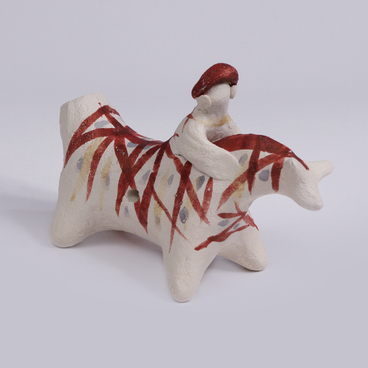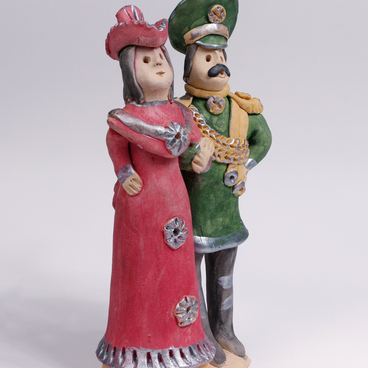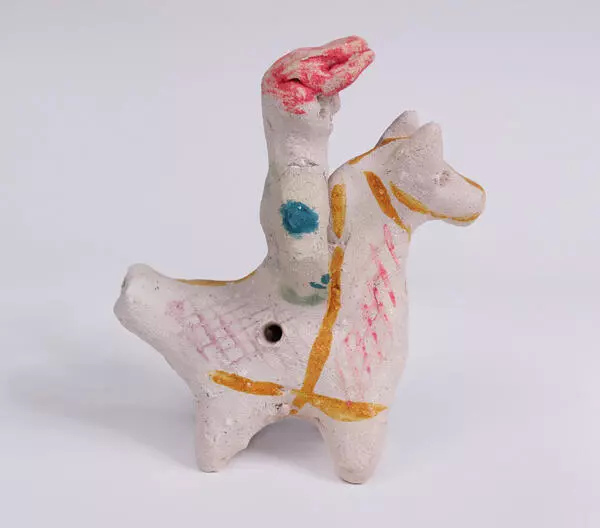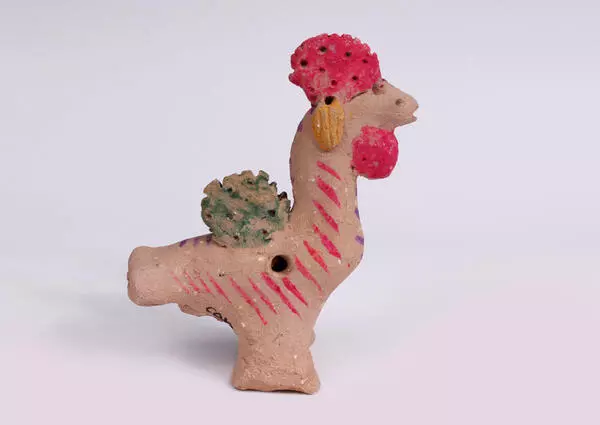A hereditary artist Olga Deriglazova made the ‘Cat’ clay toy in the 1990s. The figurine has a very simplified design, therefore it does not have discernable ears or whiskers; the animal stands on its hind legs, propped up against its tail-whistle.
The cat holds prey in its paws. Such a creative solution is not rare in Kozhlya clay toys: ceramics artists added ‘pawsies’ to many of their figurines and put miscellaneous items in them (such as an accordion, a balalaika, a pipe, an apple, a pastry, a fish, a flower, a jug, and many other things).
Kozhlya toys were extremely popular even in the past. Merchants sold them way outside the Kursk Oblast (a federal subject of Russia) — even in Turkey and Persia (modern Iran). A researcher Tatiana Skoblikova wrote that by the early 20th century, 150 dvors (families) of Kozhlya were engaged in making clay toys. The labor force mainly consisted of mothers and their daughters. There was even a set daily norm for girls — 25 whistles per day. The more girls a family had, the more toys the dvor would put up for sale. Olga Deriglazova said that her parents had five daughters, and together they made 15-20 thousand small figurines and up to 300 big ones per year.
In the 1930s, during the collectivization (the policy implemented between 1928 and 1940 during the ascension of Joseph Stalin aimed to integrate individual landholdings and labor into collectively controlled and state-controlled farms), the handicraft almost ceased to exist: the Soviet government prohibited extracting clay from the familiar quarry in Glinishche (a rural locality in Russia) situated not far away from Kozhlya. It was announced that the clay now belonged to the kolkhoz (a form of a collective farm in the Soviet Union). The government also imposed a ban on Kozhlya clay toy making, as it was now considered an activity counter to the ideology of collective labor. Not long after, the Kozhlya village suffered the Great Patriotic War, hunger, poverty, and military occupation by the German army. There were fewer and fewer ceramic craftswomen left in that area, and Kozhlya toys were the only thing that helped them survive: women would make clay figurines in secret and sell them. At first, they took the clay directly from Kozhlya’s land, but later they switched back to the familiar quarry in Glinishche.
Kozhlya toys had been revived by the beginning of the 1980s, thanks to an art historian Alexander Frumkin. He studied samples of Russian folk arts and crafts and talked to many old residents of Kozhlya. While doing this research, he discovered three artists: Olga Deriglazova, Ulyana Kovkina, and Valentina Kovkina. Due to their large contribution, Kozhlya figurines can now be seen in the All-Russia Museum of Decorative, Applied and Folk Art in Moscow, the State Russian Museum in St.Petersburg, and the museums and galleries of Omsk, Tula, and Kursk. The toys are also regularly exhibited in local and international expositions.
The cat holds prey in its paws. Such a creative solution is not rare in Kozhlya clay toys: ceramics artists added ‘pawsies’ to many of their figurines and put miscellaneous items in them (such as an accordion, a balalaika, a pipe, an apple, a pastry, a fish, a flower, a jug, and many other things).
Kozhlya toys were extremely popular even in the past. Merchants sold them way outside the Kursk Oblast (a federal subject of Russia) — even in Turkey and Persia (modern Iran). A researcher Tatiana Skoblikova wrote that by the early 20th century, 150 dvors (families) of Kozhlya were engaged in making clay toys. The labor force mainly consisted of mothers and their daughters. There was even a set daily norm for girls — 25 whistles per day. The more girls a family had, the more toys the dvor would put up for sale. Olga Deriglazova said that her parents had five daughters, and together they made 15-20 thousand small figurines and up to 300 big ones per year.
In the 1930s, during the collectivization (the policy implemented between 1928 and 1940 during the ascension of Joseph Stalin aimed to integrate individual landholdings and labor into collectively controlled and state-controlled farms), the handicraft almost ceased to exist: the Soviet government prohibited extracting clay from the familiar quarry in Glinishche (a rural locality in Russia) situated not far away from Kozhlya. It was announced that the clay now belonged to the kolkhoz (a form of a collective farm in the Soviet Union). The government also imposed a ban on Kozhlya clay toy making, as it was now considered an activity counter to the ideology of collective labor. Not long after, the Kozhlya village suffered the Great Patriotic War, hunger, poverty, and military occupation by the German army. There were fewer and fewer ceramic craftswomen left in that area, and Kozhlya toys were the only thing that helped them survive: women would make clay figurines in secret and sell them. At first, they took the clay directly from Kozhlya’s land, but later they switched back to the familiar quarry in Glinishche.
Kozhlya toys had been revived by the beginning of the 1980s, thanks to an art historian Alexander Frumkin. He studied samples of Russian folk arts and crafts and talked to many old residents of Kozhlya. While doing this research, he discovered three artists: Olga Deriglazova, Ulyana Kovkina, and Valentina Kovkina. Due to their large contribution, Kozhlya figurines can now be seen in the All-Russia Museum of Decorative, Applied and Folk Art in Moscow, the State Russian Museum in St.Petersburg, and the museums and galleries of Omsk, Tula, and Kursk. The toys are also regularly exhibited in local and international expositions.



